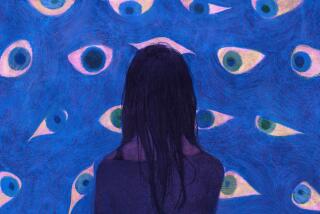Are Those Your Real Eyes? : New Tinted Contact Lenses Can Turn Brown to Blue
- Share via
EARLIER THIS year, when Whoopi Goldberg posed on the cover of a national rock magazine flashing bright blue eyes, the public may have thought the contrast was a joke. But the people who manufacture colored contact lenses weren’t laughing--they were getting ready for one of the most popular optical trends since Tom Cruise wore Wayfarers.
A few years ago, market researchers came up with data showing that half the American population would like to change their eye color. This was particularly true of dark-eyed people. Specifically, it was found that someone with brown irises coveted blue or green or hazel ones.
Wesley-Jessen Co. in Chicago, one of the country’s oldest contact-lens manufacturers, set out to create lenses that could give the illusion of making a dark iris appear a different, lighter color.
While tinted contact lenses were available to alter the color of light-colored eyes by either making them more intense or a different shade altogether--say, transform them from blue to violet--Wesley-Jessen’s DuraSoft Colors, approved by the FDA and introduced on the market last November, were the first to work for dark eyes. Suddenly all those brown-eyed people could shop for eye colors the way they choose a lipstick. The lenses are now available in blue, green, aqua and hazel. Sometime next year, violet and a more intense shade of blue will be added to the line.
The company’s colored-lenses sales figures alone--$100 million in retail sales for the first half of this year--prove, if anything, that the contacts are a fantasy fulfilled for many people. Thirty percent of sales are to people who require no vision correction whatsoever; the lenses simply are worn for a cosmetic transformation, says Tom Steiner, Wesley-Jessen’s director of marketing.
Steiner also says that the company has found a strong following among black customers. Starting this month, advertisements for the lenses, showing a black model in hazel eyes, will begin to appear in Ebony and Essence magazines.
“It’s the most revolutionary thing that’s happening in the black fashion market,” says Audrey Smaltz, a New York fashion and beauty consultant and contributor to Vogue magazine. “Oprah Winfrey has a couple of pairs. My cousin has them. The woman who assists me has only one--one green lens, and she switches left and right. I guess we blacks have a choice now. There’s not a lipstick, not a blush that’s done anything like what these contact lenses have done for blacks. It’s the beauty statement for the ‘80s.”
Still, some wearers may be surprised, even disappointed, by the way the world reacts to their newly colored eyes. Last April, Cathy Brown of West Hollywood bought pale blue contacts for her dark brown eyes. “Most of the time people don’t notice, or they say they know something’s different, but they don’t know what. Occasionally someone will say I have pretty gray eyes. That’s not what I want to hear.”
Controversial cultural implications of the trend have only begun to surface. Black director Spike Lee plans to spoof the colored-lens craze in his upcoming musical, “School Daze.” The technology that allows the lenses to modify dark eye color is an opaque pigment of color applied to the lens surface. The color is applied in a dot pattern similar to that of a natural iris, which allows some of the eye’s natural color to show through, giving an illusion of depth and naturalness. The center area of the lens covering the pupil remains clear, keeping vision unobstructed.
Dr. Barry Kolom, an Encino optometrist specializing in contact lenses, reports that many patients who try on tinted lenses find the colors are too vibrant, especially in natural light. “For film work, they’re dazzling,” says Kolom, “but in the real world many people often get asked, ‘Are those your real eyes?’ and see them as a negative. In my practice, very few people except in the film business end up actually getting them.”
Functionally, tinted lenses are no different from other soft, extended-wear contact lens. Anyone desiring a pair must be seen by an optometrist or ophthalmologist, who will examine the eyes before fitting the lenses. The price of the lenses, including fitting, is about $300, about double the cost of clear lenses.
Yet if, as surveys show, 50% of the people in America are actually displeased with their natural eye color, more optical firms will certainly enter the colored-contact-lens market. And, as demand increases, prices will surely go down. When that happens, artificial blue eyes may become as popular as artificial blond hair. And the question “‘does she or doesn’t she?” will have new meaning.
HAIR AND MAKEUP BY CASEY STOREY / STYLING BY POLLY HOYT / DRESS BY MICHELE LAMY / EARRINGS BY COMME LES GARCON / GLASSES FROM LA EYEWORKS
More to Read
Sign up for Essential California
The most important California stories and recommendations in your inbox every morning.
You may occasionally receive promotional content from the Los Angeles Times.












